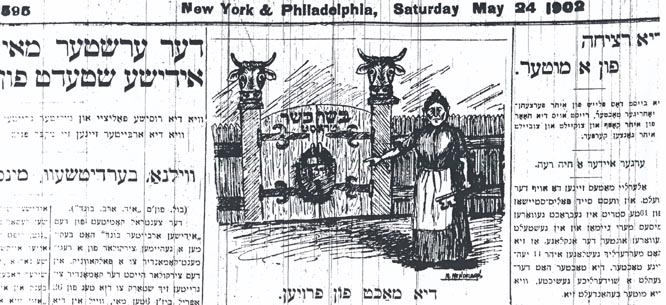The Struggle for Cheap Meat on the Lower East Side
The Struggle for Cheap Meat on the Lower East Side

Within half an hour, thousands of women had spread from one block throughout the entire Lower East Side. They broke glass and climbed into butcher shops; seized kosher chicken and beef and flung it into the streets. They forced anyone who’d bought meat to drop it where they stood. One policeman, caught defending their right to buy meat, had “an unpleasant moist piece of liver slapped in his face.”
On May 15, 1902, 20,000 people gathered in front of the New Irving Hall to declare a kosher meat boycott. As women-initiated, women-led riots spread to Brownsville, Williamsburg, and beyond, the New York Times editorial board vituperated, “It will not do to have a swarm of ignorant and infuriated women going about any part of this city . . . destroying goods and trying to set fire to the shops against whom they are angry.” The American Hebrew, writing for affluent uptown Jews, acted as if the meat riots hadn’t happened.
And yet the riots continued. What first appeared to be a spontaneous outburst of rage swelled into nearly a month of concerted efforts to lower the price of kosher meat, which had risen steeply and, Jewish women decided, become untenable for their working-class families. While men eventually took control of the leadership of the boycott, it was women who were “thrown to the pavement . . . and trampled upon [by the police]”—and women who were disproportionately arrested and heavily fined by the courts. It was women who assumed the risks that made working-class Jews’ demands urgent.
These women were not young, like garment union members, or childless, like their leaders. The boycott leaders who can be traced via census records averaged thirty-nine years of age. They were mothers, none of them with fewer than three children; Fannie Levy, the first to call for the boycott, had six children beneath the age of thirteen.
And yet, like union members, some had worked in the sweatshops before marriage. When they announced the boycott, they referred to themselves as strikers, and to those who continued to buy meat as scabs. They were traditional enough to eat kosher and interrupt Torah readings as part of their recruitment drive. But they bristled at the idea of men presiding over the boycott.
The feeling was not anomalous. As labor historian E.P. Thompson observed of the boycotters’ British forebears, it was women who made purchasing decisions on a daily basis and were thus most aware of what price hikes actually meant for their families. It was also, as Paula Hyman noted in her seminal study of the boycott, women who traversed and directed communal networks like the neighborhood, “where they pioneered in local community organizing.” The strikers massaged their neighborhood networks and turned out thousands of protesters. They also made sure to raise the social stakes against butchers and the “scabs,” who were caught within yet excluded from, to use one British author’s term, the “particular web.”
Within this web, according to Hyman, “boundary lines were fluid, and socialist rhetoric tripped easily from the tongues of women who still cared about kosher meat, could cite Biblical passages in Hebrew, and felt at ease in the synagogue.” A kind of “female consciousness,” to use Temma Kaplan’s term, took root in the minds of the boycotters, who began to realize that there was more at issue than the butchers’ prices. “They think women aren’t people, that they can bluff us; we’ll show them that we are more people than the fat millionaires who suck our blood,” one woman told the Jewish Daily Forward.
Ryan Gilliam recently staged a street musical dramatizing the boycott called “The Great Struggle for Cheap Meat.” In the show, she presents the events of 1902 with humor and an earthy optimism. The “earnestness” and “chaos” of the women’s methods, and the humbleness of their stated aim, strike her as lighthearted. For Gilliam, the New York Times’s denunciation that no one would starve over kosher meat prices rings true; but the women’s battle to defend their idea of meat—as an intimate part of the Sabbath, uniting the family once a week—is more genuine.
The Ladies’ Anti-Beef Trust Association dissolved immediately after its objective was reached. But its members helped to develop a political consciousness in neighborhoods like the Lower East Side, where Gilliam’s production takes place, that continued to reside there. Their daughters would rise as leaders of later struggles like the rent strikes of 1908 and the shirtwaist strike of 1909. During the failed 1915 referendum on women’s suffrage in New York State, the Lower East Side would display a precocious willingness to affirm women’s right to vote.
For Gilliam’s actresses, girls and young women aged between eleven and seventeen, the production is mostly a chance to work with their peers on something challenging. Although there are portions of the play’s content that horrify them, they’re most involved with the performance on a personal level. Most aren’t Jewish, but many are immigrants and most live on the Lower East Side. What the story of these events means to them they’ve yet to decide.
Nic Cavell is an intern at Dissent.






